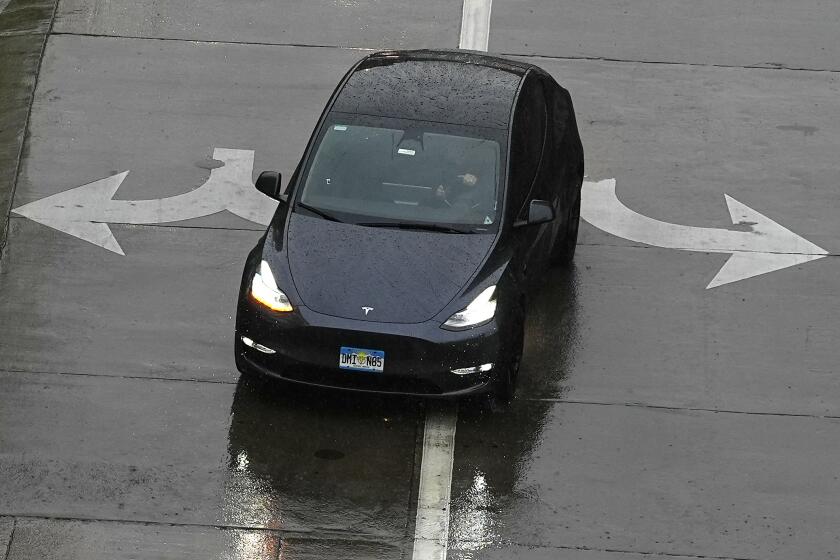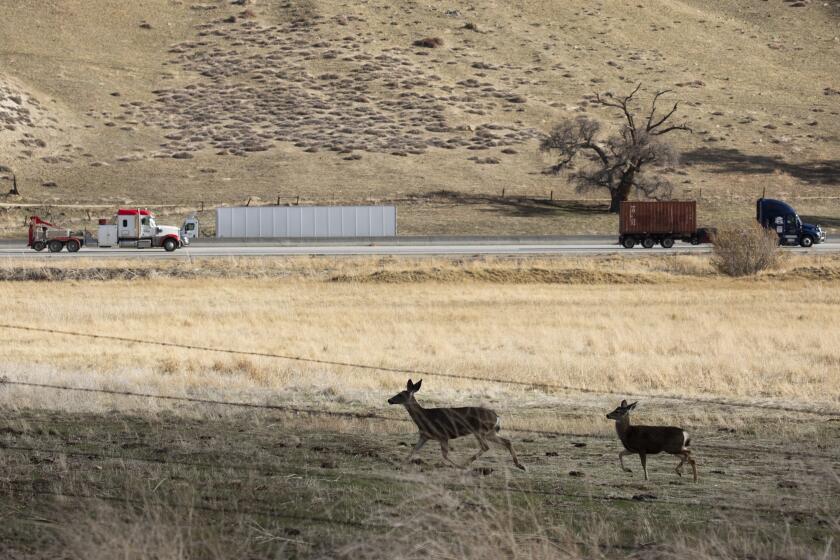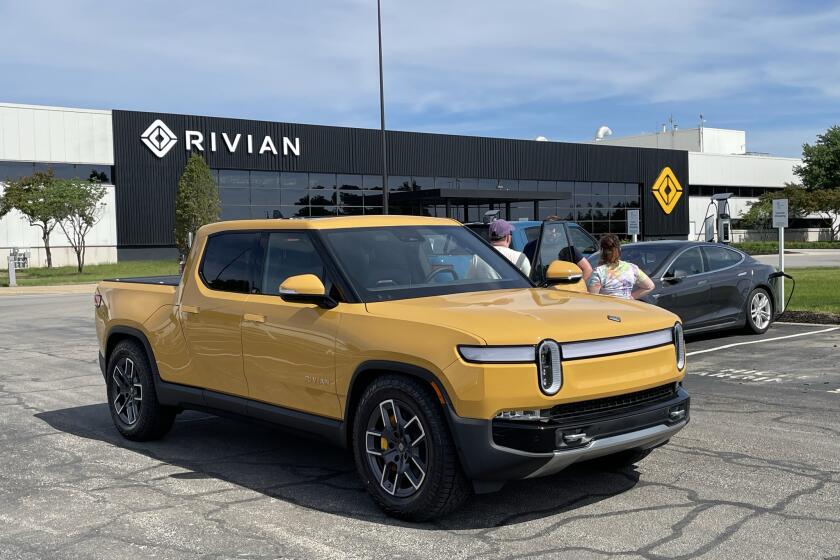HOT ROD HEAVEN : In What May Be the World Custom Car Capital, Builders Cater to People Who Know Just What They Want--and Can Afford It
C andy apple red . . . . There’s lust in that color. Flushing, pulsing, roaring teen - age lust, haloed in the gleam of a squeaky fifth coat of hi-gloss wax and the chrome intake ports of a four-banger so clean you could run your fingers over it and never touch oil.
For thousands of would-be high school top eliminators, candy apple red--or flaming orange or lemon yellow or metallic royal blue--was the color of that car, THE car, the one that could make your mouth go dry and cause you to forget completely about Mary Lou. Hello, ’32 Ford. Goodby, heart.
Now, the 17-year-old street demons of old, who in their youth may never have slid behind the wheel of their fantasy car, never closed their fingers lovingly around the shift knob of their one, ultimate hot rod, never quite gotten a grip on that apparition quivering in a dream haze of burning rubber . . . now those would-be speed merchants are in their middle years. And they have money.
And in Orange County, which may be the hot rod capital of the universe, they know exactly how they want to spend it.
It was no accident that the Beach Boys in the 1960s found an enthusiastic audience in Southern California for songs such as “Little Deuce Coupe” and “Fun, Fun, Fun.” For nearly 15 years, Southern California had been crazy for cars that were chopped, channeled, lowered, jacked up, tricked out, modified, blown, supercharged or that could just go like hell. On weekends, garages in neighborhoods all over the map hummed with the sound of hundreds of amateur builders lovingly slapping together their own personal cruising machines.
Then, within a decade, they were all but gone.
The late ‘60s ushered in the era of the “muscle car”--mass-produced, high-performance models built by Detroit automakers eager to tap into the market of buyers who wanted power, speed, sleek lines and relative affordability.
But, said Geoff Carter, editor and associate publisher of Anaheim-based Street Rodder magazine, just as the high cost of parts began driving the vintage hot rods into obscurity in the ‘60s, high insurance premiums eventually doomed the muscle cars by the early 1970s.
Then, Carter said, with the establishment of the National Street Rod Assn. in 1970, along with the advancing maturity and fattening bank accounts of many of the old hot rod fans of the ‘50s and early ‘60s, hot rodding slowly began to re-emerge under the skilled hands of professional builders who would provide the former “bench racers” with their dream machines.
And many of these pilgrims came--and are still coming--to Orange County.
“The businesses and the people who have taken street rod building to a professional level are largely here on the West Coast,” Carter said. “It’s been that way since the Second World War. But today the balance seems to have shifted from L.A. to Orange County as far as the concentration of the number of car owners and car builders.”
The man who is probably the best known of these latter-day hot rod builders is Boyd Coddington. His business, Hot Rods by Boyd, has been operating out of a backwater industrial park in Stanton for the last three years. Today, he and his staff of 26 may be “working on 20 cars at any one time,” he said.
The garage and workshop areas are filled with engines, chassis, wheels, bodies and entire cars in various stages of construction. When the hot rods are completed, they will sell for $25,000 to $100,000. Some will go even higher. All the work has been commissioned, Coddington said. The customers will have no trouble paying for it.
“We do a terrific amount of business with the oil people in Texas,” he said. “They can be people who may have had (a street rod) when they were younger or maybe couldn’t afford one then but always wanted one. Now they can have one, but they don’t have the time to work on it themselves. But they still want it, so they come to us.”
Coddington said he always wanted one.
“My first car was a T bucket (a modified Model T) when I was 13. I read Hot Rod magazine since I was old enough to read, and in about 1968 or ’69 I was building a car a year.”
Turning 1932 Ford roadsters from scrap into gleaming showpieces is something of a specialty with Coddington, who said that particular car “will always be popular” with hot rod fans.
In another part of the shop, two late-model Ferraris were also undergoing modifications. Coddington made it plain that such effete autos are no favorites of his.
“Usually, the people who drive the exotic sports cars are the Newport Beach crowd, the guys with all the gold chains around their necks,” he said. “But they’re popular. Ferrari can’t make enough of them.”
Such Italianate frills are not for Mike McKeown, either. McKeown, 43, a painting contractor from Las Vegas, is a typical Coddington customer.
“I grew up in Huntington Beach,” he said, “and I had a real hot ’55 Chevy years ago. Since I’ve been real successful in business, I’ve gotten back into the cars, but I can’t work on them. I just don’t have time.”
McKeown said he was commissioning Coddington to build an aluminum roadster from scratch, but, nodding to a nearly complete and immaculate candy apple red 1932 Ford Victoria sitting on the shop floor, he confessed that he was thinking of buying that one, too.
“I just love them,” he said. “You drive down the street in a car like that, and you’ll see some old guy and he’ll say, ‘Oh, God, Henrietta! I had one just like that, but that’s sure a brighter red than mine was.”’
Some custom hot rods bear little resemblance to their original incarnations. A pair of ’32 Ford sedans customized by another top Orange County hot rod builder, Jack Robinson, look a bit more like rockets than tin lizzies. One is a gleaming yellow convertible, intended for the wife of the customer. The other, a gunmetal gray job with a computerized injection 302-cubic-inch Chevy engine, is for the customer, a Chino auto auctioneer. Robinson said it’s worth about $100,000.
“It’s outta hand,” said Robinson, who is known in Orange County hot rodding circles as Fat Jack and whose business--only a long block away from Coddington’s--is called Fat Jack Enterprises.
“The cost is just outta hand. That’s why you don’t see any kids in it anymore.”
However, he added, the people with the money seem to know where to bring it.
“For this business, Southern California would be hard to beat out of the whole United States,” he said. “Actually, out of the whole world. All of us (builders) just seemed to land here.”
Fat Jack achieved his greatest fame, he said, with a 1946 Ford coupe. Called “Fat Attack,” it was painted an almost glowing orange and could, he said, reach a speed of 150 m.p.h. on a drag strip. It was destroyed when a driver rolled it during a “nostalgia drag race,” one of the periodic drag meets open to builders and drivers of hot rods.
Fat Jack, 44, said he obtained his first car at age 9--a 1940s Ford sedan. “I took it apart and put it back together,” he said.
At 13, he acquired a ’32 Ford three-window coupe and worked on it for three years, until he could legally drive it at age 16. At one time, he said, he was so crazy about ’32 Fords that he had 15 of them.
He gave up a job as a construction worker about 14 years ago to build cars full time. A lower-volume producer than Coddington, he said his shop turns out about one car a year. Like Coddington, however, most of his money is realized through a mail-order auto parts business.
“I build stuff to drive and use,” he said. “These cars are no good sitting around. You’ve got to drive ‘em. I was always crazy for building things and going fast,” he said. “The idea has always been to go fast, but now that’s become more of a habit. People want them more for the looks.”
Such evolution doesn’t surprise Ed (Big Daddy) Roth. A hot rod builder since the 1940s, Roth became known, principally in the ‘60s, as something of a wild man in the custom hot rod business. Not content with merely modifying existing bodies, he molded his own, creating oddities such as the bubble-topped “Beatnik Bandit,” the “Mysterion” and other improbable but workable--and fast--hot rods. He also originated the popular Rat Fink cartoon character.
Today, he is concentrating his car building energies on high-technology methods. A resident of La Mirada, his current pet project is taking shape in a garage in Westminster. It is a car, which he intends to call “L.A. Zoom,” that will be built mostly of a combination of graphite and Kevlar and will weigh, he claims, less than 500 pounds--with engine. He expects to finish it by 1991.
“I’ve never built any car for money,” he said. “I just build what I think is going to happen in the future. I get ideas and start to think about cars years ahead. I’ve built about one car a year for the past 30 years.”
A current Roth project is a light three-wheeled vehicle he calls “Globe Hopper.” Built of material similar to that in “L.A. Zoom,” it recently survived a trip from Southern California to Alaska, across Canada to New York and home again. Observers along the journey, he said, told him the car looked like a two-eyed sloth, a crab and a lawn mower, among other descriptions. It is unique, he said, in that it has no metal frame.
Such cars, he said, have always found receptive audiences in Southern California.
“The whole world is always looking at California to lead (in hot rod building),” he said. “Everything always starts here. All the speed equipment guys are concentrated here, and they make it possible to build these cars. If you’re in Kansas, you can be stuck.”
Southern California--and now particularly Orange County under the leadership of Coddington--has set what Roth calls a “standard of hipness” for hot rod building.
“Everybody’s watching Boyd,” he said. “He’s doing far-out work and he’s keeping the standard. In fact, Stanton may be the center of everything right now.
“There’s a real difference between, say, the East Coast and here. On the East Coast, guys take their cars out and drive them for a while and then put them back in the garage for the winter. Out here, a guy is married to his car.”
Bill Kiefer agrees.
“It’s roadster weather out here all the time, right?” said Kiefer, owner of California Custom Roadsters, a parts and hot rod building business in Orange.
“We’re the trend setters. In New York, they go for fancy apartments and people; in New York, it’s who you know. In Southern California, it’s what you drive. This area is probably the car capital of the world.”
But today’s middle-aged rodders have mellowed, he said.
“They’ve been trying to change the image of the old hot rodder,” said Kiefer, 41. “They call themselves street rodders now. They don’t go around burning the tires anymore and hot rodding around town. The cars today are cruisers, not really hot rods. You’re out there to say, ‘Hey, look at me,’ not to burn up the street.”
Like other professional builders, Kiefer said his parts business sustains his penchant for hot rod building.
“We don’t get paid what the cars are probably worth,” he said. “You look on the building as research and development to keep up with the parts business.”
The fun, most hot rodders will say, comes from showing off. David (Doc) Gibson, a 48-year-old chiropractor from Laguna Hills, obviously enjoyed the looks his 1939 Ford Standard sedan was getting at a recent weekend gathering of the Outriders, an Orange County hot rodders’ club.
Dozens of cars were parked end to end in a remote Huntington Beach lot set aside for the picnic, and Gibson’s car--candy apple red with orange flames on the sides--was enjoying a good amount of attention from the strolling club members.
Gibson is the founder of the Orange County Cruise Assn., a group of rodders who gather on the second Saturday of each month at Orange County shopping center parking lots to ogle each other’s cars.
“I had my first hot rod, a ’36 Ford three-window coupe, in 1952 when I was 14,” Gibson said. “Now I don’t have the time or the tools necessary to work on a car, so I have them done for me. I love them.
“These are down-to-earth people, and it seems like there always have been hot rods. I’m thinking of selling two of my Corvettes so I can build a ’34 Ford full-fender roadster.
“Some of the people who restore cars (to original condition) say, ‘Why would you want to cut up a beautiful car like that?’ Well, we wonder why they wouldn’t want to modify it. It makes you think they must have been a real square when they were younger.”
Dave Butler, 42, who lives in Cypress and owns a grading company, is another Outrider who grew up with hot rods. He’s owned 10 of them since high school. His latest is a modified 1929 Model A roadster with a 430-cubic-inch Donovan engine. It is worth, he estimated, around $100,000. The all-black car can reach 140 m.p.h. on the drag strip, he said. Its moniker is written in gray script below the grille: Pure Hell.
“You drive this thing up the coast or up I-5,” he said, “and it’s so smooth.”
It’s also nearly lethal. A two-second burst of high acceleration produces a cloud of tire smoke that can be smelled for a hundred yards.
For all the money, for all the time, for all the work, for all the wax jobs, the oil changes and the lubes in the middle of the night, for all the polishing of the chrome, the minute tune-ups, the often achingly low gas mileage, for all the tender loving care, none of the builders, owners or fans said they saw their hot rods as anything more than wonderful, loud, satisfying toys.



